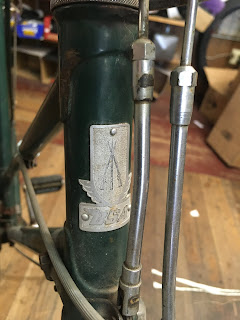This thing has been getting workout this summer:
The 70-year-old BSA was followed by a 50-year-old Raleigh Sprite. The owner of the Sprite said that he had bought it new and loved the bike, and had ridden it everywhere for years before it got hung up in a barn somewhere for many more years. When it came in, it was thickly coated with bird crap. The estimate to return it to rideable condition was several hundred dollars. The owner initially said that maybe it was time to say farewell, but called back later to tell us to go ahead.
In the early 1970s, it was up to you to figure out how high to put your stem.
No max height/minimum insertion line here.
The bike hadn't seen new grease in any of the bearings since the early 1970s. I may be wrong about that, but if it was ever overhauled it was probably no later than the late 1970s. The bearings are all designed to be serviced. But everything needed extensive cleaning. Hence the hefty estimate. And I told him at the outset that it would not be like new.
The bottom bracket was full of tiny seeds and a small acorn that rodents must have dropped in through the opening in the top of the straight steel seatpost.
The bottom bracket axle had a little engraving on it. It looks like it might be a picture of a rider.
I was too busy to document the whole thing. Another three speed from about the 1960s waits in the queue.
Other jobs included fixing the control lever for a guy's dropper post on his Trek somethingorother. The special screw had fallen out, so the lever was all afloat.
The threading is easy. There are basically only two thread sizes for parts and accessories, and this was the smaller one. As a shorthand I call it "water bottle thread." We have lots of bolts in varying lengths for the many applications in which they're used. About a 12mm button head with a couple of washers would do, except for the difference in diameter between the shaft on which the lever mounts and the inside diameter of the hole on the lever itself. Because the unit is only available as a complete assembly, the Internet could not tell me what the regulation innards look like. I scrounged around until I found a donor for the bushing I envisioned.
Who remembers Cannondale's annoying Force 40 brake enhancing cam from the early 1990s? We have a bag of these lying around. I pressed the pivot bushing out of this one and cut it in half.
The improvised bushing fit perfectly.
Another rider's weekend saved.
On to the next thing.
What the hell is lianium?
This stem was on a bike that a young guy was building for himself from items he'd ordered online. He could do most of it, but wanted us to cut the fork and check a couple of other things. Lianium? Maybe it was supposed to say titanium. Sort of like what happened to this knockoff of a Shimano freewheel:
Here's what they're ripping off:
****
Top-routed cables led to a variety of approaches to the direction of cable pull on front derailleurs. There are front derailleurs made for the cable to pull from above, as well as models with a cam arrangement that will accommodate cable routing from above or below. But when top route cables were a new concept, designers used a directional pulley at the bottom of the seat tube to run the cable around and up to the traditional bottom-pull derailleurs that everyone had to use. This method is still in use, along with all the others.
The directional pulley is supposed to rotate smoothly on that rust-encrusted, deeply pitted bushing, which was smooth and shiny before the bike was ridden in wet and wintry weather, and probably cleaned with a hose. Between parts that are not available because of the pandemic disrupting things, and parts that were never available as replacement bits, recovering crudded-up pieces like this has become routine.
Lots more has gone by without a picture or notes in the relentless flow of repair work, but some things merit a moment to immortalize. The owner of this bike balked at the complete estimate to make it even remotely safe, including replacing the broken fork.
She insisted that she only rides it very mildly with her kiddies, and has been doing it with the fork in this condition for years. Then when she picked the bike up she said she was taking it to Highlands mountain bike park, but she "would only go on the easy trails." Hopefully her kiddies won't have to learn to spell "quadriplegic" any time soon.

























